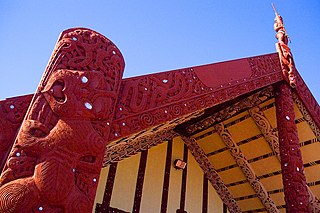
Māori culture involves the customs, cultural practices, and beliefs of the indigenous Māori people of New Zealand. It originated from, and is still part of, Eastern Polynesian culture. Māori culture also forms a distinctive part of New Zealand culture and, due to a large diaspora and the incorporation of Māori motifs into popular culture, is found throughout the world. Within Māoridom, and to a lesser extent throughout New Zealand as a whole, the word Māoritanga is often used as an approximate synonym for Māori culture, the Māori-language suffix -tanga being roughly equivalent to the qualitative noun-ending -ness in English. Māoritanga has also been translated as "[a] Māori way of life."

Indigenous Australian art includes art made by Aboriginal Australian and Torres Strait Islander peoples of Australia, including collaborations with others. It includes works in a wide range of media including painting on leaves, bark painting, wood carving, rock carving, watercolour painting, sculpting, ceremonial clothing and sand painting; art by Indigenous Australians that pre-dates European colonisation by thousands of years, up to the present day.

African art describes the modern and historical paintings, sculptures, installations, and other visual culture from native or indigenous Africans and the African continent. The definition may also include the art of the African diasporas, such as African American, Caribbean or art in South American societies inspired by African traditions. Despite this diversity, there are unifying artistic themes present, when considering the totality of the visual culture from the continent of Africa.

New Ireland Province, formerly New Mecklenburg, is the most northeastern province of Papua New Guinea.

A marae, malaʻe, meʻae or malae is a communal or sacred place that serves religious and social purposes in Polynesian societies. In all these languages, the term also means cleared, free of weeds, trees. Marae generally consist of an area of cleared land roughly rectangular, bordered with stones or wooden posts perhaps with paepae (terraces) which were traditionally used for ceremonial purposes; and in some cases, a central stone ahu or a'u. In the Rapa Nui culture of Easter Island, the term ahu has become a synonym for the whole marae complex.
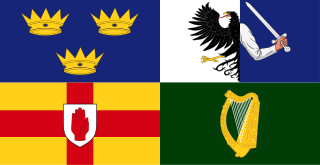
The culture of Ireland includes language, literature, music, art, folklore, cuisine, and sport associated with Ireland and the Irish people. For most of its recorded history, Irish culture has been primarily Gaelic. It has also been influenced by Anglo-Norman, English and Scottish culture. The Anglo-Normans invaded Ireland in the 12th century, and the 16th/17th century conquest and colonisation of Ireland saw the emergence of the Anglo-Irish and Scots-Irish.

Samoans or Samoan people are the indigenous Polynesian people of the Samoan Islands, an archipelago in Polynesia, who speak the Samoan language. The group's home islands are politically and geographically divided between the Independent State of Samoa and American Samoa, an unincorporated territory of the United States of America. Though divided by government, the culture and language remain the same.
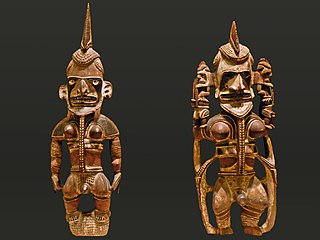
Uli figures are wooden statues from New Ireland in Papua New Guinea. Like their neighbors to the north and south, the artistic traditions of the peoples of central New Ireland formerly focused largely around mortuary rites. In contrast to the intricate malagan carvings of the north, artists in central New Ireland produced less ornate but more permanent figures known as uli, which were kept and reused many times. No longer made today, uli were displayed as part of lengthy fertility rites involving the exhumation and reburial of human skulls, which accompanied the planting of sacred plants.

The culture of Papua New Guinea is many-sided and complex. It is estimated that more than 7000 different cultural groups exist in Papua New Guinea, and most groups have their own language. Because of this diversity, in which they take pride, many different styles of cultural expression have emerged; each group has created its own expressive forms in art, dance, weaponry, costumes, singing, music, architecture and much more. To unify the nation, the language Tok Pisin, once called Neo-Melanesian has evolved as the lingua franca — the medium through which diverse language groups are able to communicate with one another in Parliament, in the news media, and elsewhere. People typically live in villages or dispersed hamlets which rely on the subsistence farming of yams and taro. The principal livestock in traditional Papua New Guinea is the oceanic pig.
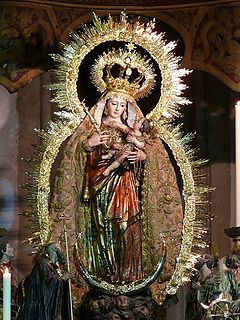
A santo is a piece of one of various religious art forms found in Spain and areas that were colonies of the Kingdom of Spain, consisting of wooden or ivory statues that depict various saints, angels, or Marian titles, or one of the personages of the Holy Trinity. A santero is a craftsperson who makes the image. Some santos which have gained greater public devotion among the faithful have also merited papal approval through canonical coronations. Santos remain a living tradition of religious iconography and folk art in Mexico, the Philippines, Puerto Rico and some other Caribbean islands, South and Central America, and the Southwestern United States, especially New Mexico.
Like many of Taiwan's older cities, Taichung has a large number of old temples and shrines that have historical value and are typical of the eras in which they were built. They include family and public Taoist and Buddhist temples, a Confucian temple, and even a Japanese Shinto Shrine.
Australian Aboriginal culture includes a number of practices and ceremonies centered on a belief in the Dreamtime and other mythology. Reverence and respect for the land and oral traditions are emphasised. Language and other groupings exhibit a range of individual cultures. Australian Aboriginal art has existed for thousands of years and ranges from ancient rock art to modern watercolour landscapes. Aboriginal music has developed a number of unique instruments. Contemporary Australian Aboriginal music spans many genres. Aboriginal peoples did not develop a system of writing before colonisation, but there was a huge variety of languages, including sign languages.

Tongkonan is the traditional ancestral house, or rumah adat of the Torajan people, in South Sulawesi, Indonesia. Tongkonan have a distinguishing boat-shaped and oversized saddleback roof. Like most of Indo's Austronesian-based traditional architecture tongkonan are built on piles. The construction of tongkonan is laborious work and it is usually built with the help of all family members or friends. In the original Toraja society, only nobles had the right to build tongkonan. Commoners live in smaller and less decorated homes called banua.
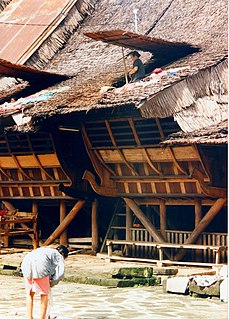
The Omo sebua is a traditional house style of the Nias people from Nias island, Indonesia. They are built only for the houses of village's chiefs. Situated in the centre of a village, omo sebua are built on massive ironwood piles and have towering roofs. Nias culture, with former frequent inter-village warfare, has made the design of omo sebua impregnable to attack. The houses' sole access is through a narrow staircase with a small trap door above. The steeply pitched roofs can reach 16 metres in height. Apart from a strong defense against enemies, omo sebua have proven earthquake resistance.

New Ireland or Latangai, is a large island in Papua New Guinea, approximately 7,404 km2 (2,859 sq mi) in area with c. 120,000 people. It is named after the island of Ireland. It is the largest island of New Ireland Province, lying northeast of the island of New Britain. Both islands are part of the Bismarck Archipelago, named after Otto von Bismarck, and they are separated by Saint George's Channel. The administrative centre of the island and of New Ireland province is the town of Kavieng located at the northern end of the island. While the island was part of German New Guinea, it was named Neumecklenburg.

The Tabar Group is an island group in Papua New Guinea, located 40 km north of New Ireland. It is a part of the Bismarck Archipelago. The Tabar group consists of a short chain of three main islands - Tabar Island in the south, Tatau Island in the center, and Simberi Island in the north - as well as a number of smaller offshore islets. The highest peak is Mount Beirari at 622 metres.
Nalik culture is the traditional culture of the Nalik people of northern New Ireland in Papua New Guinea. The Nalik language is spoken by approximately 5000 people, based in 14 villages on the east coast of New Ireland, and 3 on the west coast. A significant number of Nalik speakers live outside the language area, in Kavieng, Port Moresby and elsewhere.
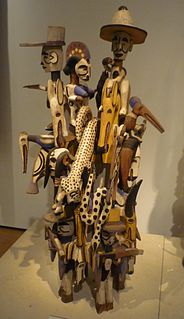
Igbo art is any piece of visual art originating from the Igbo people. The Igbo produce a wide variety of art including traditional figures, masks, artifacts and textiles, plus works in metals such as bronze. Artworks from the Igbo have been found from as early as 9th century with the bronze artifacts found at Igbo Ukwu. With processes of colonization and imperialism, the vocabulary of fine art and art history came to interact with established traditions. Therefore, the term can also refer to contemporary works of art produced in response to global demands and interactions.

A tatanua is a type of traditional mask made by the natives in the province of New Ireland, Papua New Guinea. The masks are made of wood and other natural materials and used in funeral ceremonies called malagan.

















